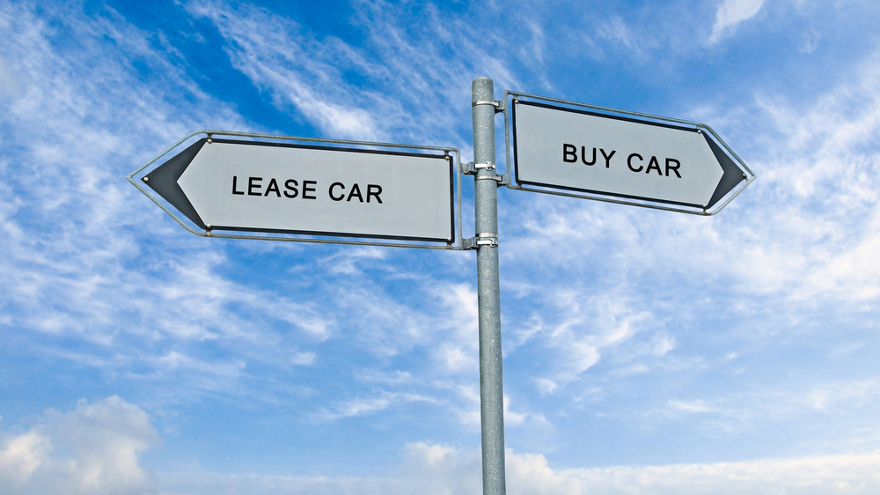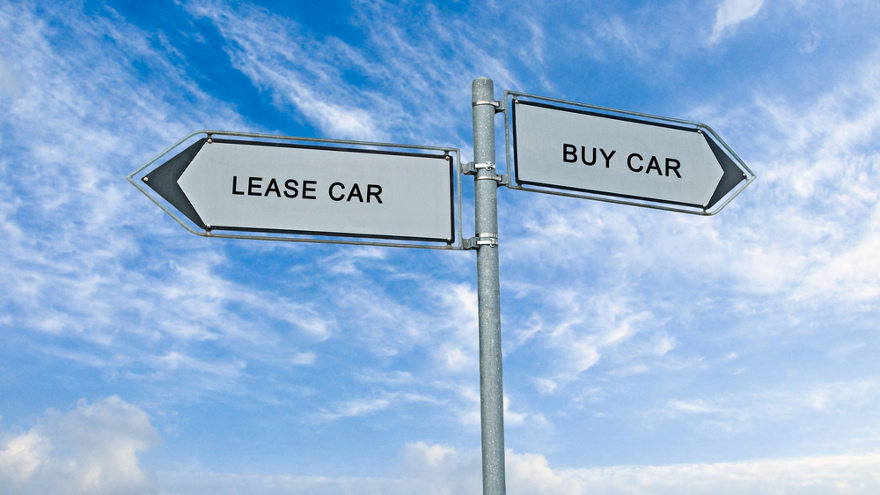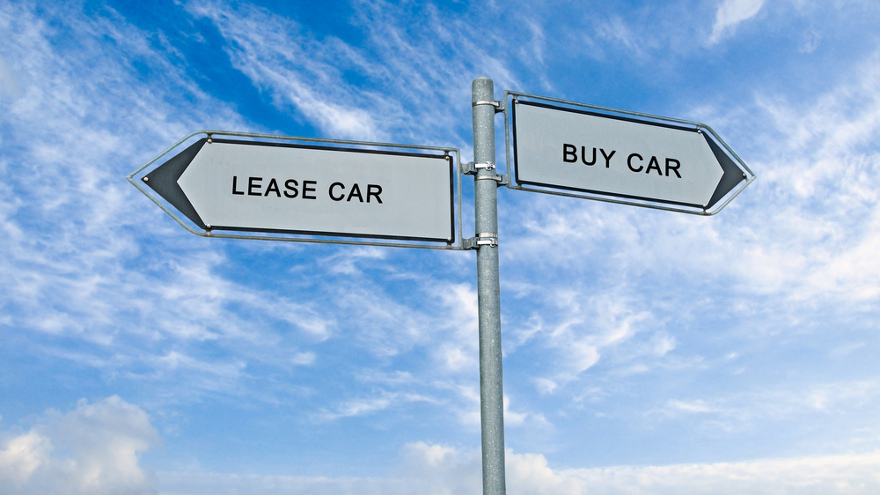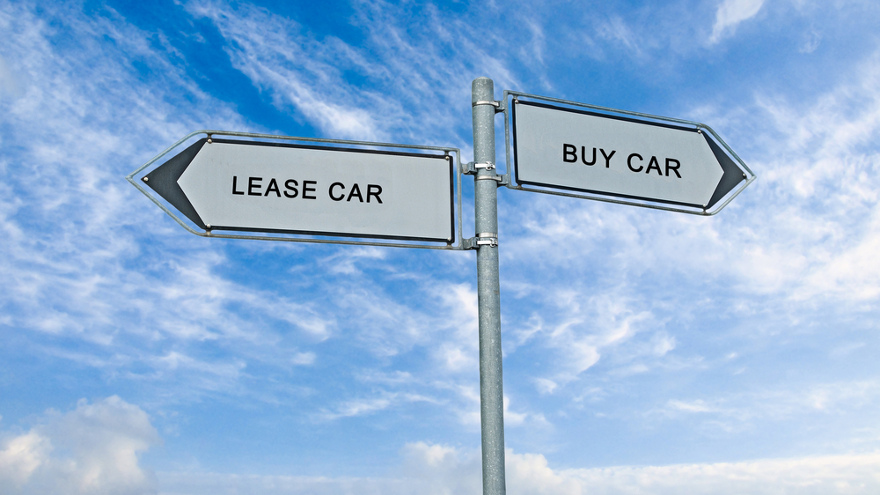Dealerships are likely to see quite a wave of customers coming back to their showrooms this year since leased vehicles they delivered three years ago are set to mature.
Along with handling that influx of traffic, store staff also might have another challenge — explaining to the happy lease customer that putting them into another leased vehicle is going to cost them more money.
According to new analysis from Edmunds, the record 4.3 million Americans who will be turning in leased vehicles this year will be in for “sticker shock” when they return to the dealership.
Analysts shared on Wednesday that consumers who are leasing some of the most popular vehicles and want to lease the same vehicle again will find themselves paying as much as 26 percent more than they did in 2016, and more than $1,600 over the life of the lease on average.
Edmunds explained that record-high vehicle prices, weakening residuals and rising interest rates are mostly to blame for the increases, which analysts say are substantial enough to potentially price many shoppers out of the new-vehicle market.
“Three years ago, leasing was an affordable option for almost anyone considering a new vehicle, but the market has made a pretty dramatic shift since then,” said Jessica Caldwell, executive director of industry analysis for Edmunds.
“Demand for sedans has fallen off so sharply that they don’t hold their residual value like they used to, making lease payments much more expensive. Couple that with the record-high vehicle prices and soaring interest rates, and car shoppers who may have only ever leased are now going to be facing some tough decisions,” Caldwell continued.
Experian’s Q4 2018 State of the Automotive Finance Market report highlighted the Top 10 most popular vehicle leased during the closing quarter of last year. The rundown broken down by market share included:
1. Chevrolet Equinox: 3.8 percent
2. Toyota RAV4: 3.2 percent
3. Honda Civic: 2.9 percent
4. Jeep Grand Cherokee: 2.5 percent
5. Nissan Rogue: 2.4 percent
6. RAM 1500: 2.4 percent
7. Ford F-150: 2.3 percent
8. Honda Accord: 2.3 percent
9. Jeep Cherokee: 1.9 percent
10. Ford Escape: 1.9 percent
Edmunds reviewed the most popular vehicles leased in the U.S. to reveal which ones have the most pronounced hikes in lease costs now compared to 2016, looking at identical models and trim levels. The Toyota Camry SE had the biggest spike, costing $2,834 more on average over the course of a 36-month lease ― a 26-percent increase.
Analysts said these price increases could also be “another nail in the coffin” of the sedan market, as the price gap between SUVs and cars has narrowed considerably since 2016 on some of the most popular vehicles.
For example, in 2016, Edmunds noted it cost $1,746 more on average to lease a Honda CR-V LX AWD than a Honda Accord LX, but now that CR-V is only $37 more over the course of a 36-month lease. In 2016, buyers would have had to pay an average of $2,318 more to lease a RAV4 LE AWD compared to a Camry SE, but now that RAV4 is only $1,313 more on average over a 36-month lease.
Edmunds consumer advice editors said vehicles shoppers who find themselves faced with these higher costs do have options, but they need to keep an open mind.
“If your lease is ending this year and costs seem beyond your budget, it might be time to reconsider your approach to leasing or even consider buying used,” said Matt Jones, senior consumer advice editor at Edmunds. “Many automakers are offering low interest rate deals on their certified pre-owned vehicles, which is one great way to get a relatively new car for a comparatively low price.”
In addition to looking into certified pre-owned vehicles, Edmunds added that vehicles shoppers coming out of a lease should consider:
● Extending the lease: Most leasing companies will extend a lease for a period between a month and a year, giving shoppers time to consider a longer-term solution.
● Switching brands: Many automakers offer attractive deals to whom they call “conquest” shoppers who are trading in a vehicle from a direct competitor. This kind of deal could be enough to offset the price increase a shopper could be facing by staying with the same make and model.
● Checking for equity: Shoppers who leased an SUV may be pleasantly surprised to find out their vehicle is actually worth more than the residual value set at the start of the lease. Car shoppers can see if their vehicle has equity by looking online for its value and comparing it to the residual buyout amount. These funds can be used toward your next vehicle to reduce the monthly payment.
If dealerships encounter customers who are still unsure of what to do, they could point to this Experian data that showed the difference in average monthly payment for a lease versus a retail installment sales contract with traditional financing. Experian used that Top 10 list to highlight that data set.
1. Chevrolet Equinox: $445 for a loan and $304 for a lease
2. Toyota RAV4: $459 for a loan and $346 for a lease
3. Honda Civic: $420 for a loan and $314 for a lease
4. Jeep Grand Cherokee: $604 for a loan and $463 for a lease
5. Nissan Rogue: $465 for a loan and $346 for a lease
6. RAM 1500: $650 for a loan and $441 for a lease
7. Ford F-150: $652 for a loan and $450 for a lease
8. Honda Accord: $485 for a loan and $376 for a lease
9. Jeep Cherokee: $492 for a loan and $357 for a lease
10. Ford Escape: $434 for a loan and $329 for a lease
Edmunds Lease Analysis
|
VEHICLE
|
Total Lease Cost % Increase 2016 vs. 2019*
|
|
Toyota Camry SE
|
26%
|
|
Toyota Corolla LE
|
22%
|
|
Honda Accord LX
|
21%
|
|
Volkswagen Jetta 1.4T S
|
20%
|
|
Honda Civic LX
|
19%
|
|
Toyota RAV4 LE AWD
|
14%
|
|
Ford Escape SE AWD
|
12%
|
|
Nissan Rogue SV AWD
|
12%
|
|
Nissan Altima 2.5 S
|
5%
|
|
Jeep Grand Cherokee Limited AWD
|
4%
|
|
*Calculations based on Edmunds transaction data comparing each vehicle’s total cost (including monthly payment and down payment) over the course of a 36-month lease signed in 2016 and 2019. For consistency, Edmunds analysts only compared vehicles with the same style available in both years.
|
Coming on the heels of a notable anniversary, Credit Union Leasing of America decided to refresh its look.
On Wednesday, the provider of indirect vehicle leasing programs for credit unions, unveiled a new logo, website design and other brand elements all in an effort to reflect a modernized approach that emphasizes the benefits indirect vehicle leasing can provide credit unions. CULA said these benefits include higher yield, a diversified loan portfolio and enhanced member services.
With the refreshed brand and website, CULA aims to make it easier for credit unions to achieve their goals in these areas.
“CULA celebrated its 30th anniversary in 2018. Even as we celebrated achieving that milestone we were already looking ahead to the next 30 years. Our goal was to determine how we could improve our services for credit unions and their members and convey that improvement through every interaction with our company,” CULA chief executive officer John Thomas said.
“Our refreshed brand and streamlined website better reflect the enduring, trusted and forward-thinking company we’ve become. This new look will take us well into the future,” Thomas continued.
The company said the brand refresh will be a continual process throughout the year. Updates to the CULA lessee and dealer portals are already in development.
“Our clients are credit union innovators who are leaders in their markets. In 2018, our lenders originated $1.2 billion in indirect vehicle leases,” said Ken Sopp, CULA’s chairman. “To support these innovative leaders, it’s imperative that we continually evolve.
“This refreshed brand and forthcoming portal enhancements demonstrate CULA’s drive to grow and innovate,” Sopp said.
Visit www.cula.com to learn more.
Auto Financial Group, one of the nation’s leading sources of residual based financing and vehicle remarketing for financial institutions, enjoyed more client signings during the fourth quarter.
During the quarter, AFG said it signed a total of seven new credit unions and six institutions agreed to join the AFG Balloon Lending Program. According to a news release distributed on Wednesday, that group of six credit unions includes:
— Shell Federal Credit Union
— Honolulu Federal Credit Union
— Pheple Federal Credit Union
— Marion Community Credit Union
— SECNY Federal Credit Union
The company added that Forest Area Federal Credit Union also will be implementing the AFG Leasing Program, which continues to build momentum since it launched in 2016.
AFG highlighted these seven credit unions represent combined assets of more than $2.4 billion and a reach increase of nearly 5.9 million consumers across seven states.
“In an environment that continues to push the limits of affordability for vehicles, with average monthly payments now exceeding $525 per month according to Edmunds, credit unions are eager to sign up for the AFG Residual Based Financing Programs to gain a competitive advantage,” AFG chief executive officer Richard Epley said.
“The programs allow credit unions to offer a lower payment vehicle financing option to borrowers,” Epley continued.
To learn more about AFG’s programs, go to www.autofinancialgroup.com/products.
Lexus recently rolled out one of the latest attempts by automakers to launch a leasing program that bundles together insurance, scheduled maintenance and other services into a single payment.
In light of how complicated projecting residual values are in conjunction with traditional vehicle leasing, Auto Remarketing gathered assessments from an array of industry experts who reviewed the automaker’s program that’s available at nearly 80 Lexus dealerships in seven states.
To recap, the new full-service Lexus Complete Lease includes a 20,000-mile, two-year term, which combines the cost of the lease with maintenance, insurance and additional services in one monthly payment. The innovative Lexus Complete Lease is currently available for qualifying consumers who choose any Lexus UX available in seven states — California, Florida, Illinois, Indiana, Massachusetts, New Hampshire and Rhode Island.
Anil Goyal, executive vice president of operations at Black Book, noted, “24-month leases offer flexibility to upgrade into a new vehicle sooner, but depreciation is also steepest in the first two years, raising the expense. The bundled benefits offer convenience and are likely to appeal to the subscription-seeking customer.
“The price point will be important — it will be interesting to see how Lexus prices it. The mileage allowance is low for a typical driver, and the miles overage could add up,” Goyal continued.
Morgan Hansen, director of data science at ALG, explained why the residual value of these particular Lexus models makes it feasible for the automaker to try this program.
“The UX is an all-new product from Lexus that has two key features working into its advantage. Price and consumer demand,” Hansen said. “The UX is the most affordable Lexus available, keeping payments lower, and it is coming into a popular emerging segment of vehicles, premium subcompact utility.”
Eric Ibara offered a similar assessment. Ibara is director of residual values consulting at Kelley Blue Book.
“As Kelley Blue Book’s winner of the lowest Cost-to-Own award in the luxury subcompact crossover category, the UX seems a natural choice for Lexus to select in its inaugural Lexus Complete Lease program,” Ibara said.
“While it’s interesting that the UX does not have the lowest projected maintenance nor insurance cost in its category, its depreciation is expected to be lower by thousands of dollars than anything else in the segment,” Ibara continued. “This more than makes up for the slightly higher expected maintenance and insurance costs.”
Other attempts by OEMs
Lexus isn’t the first luxury badge to launch this kind of product.
Back in November 2017, Cadillac tried a program called BOOK by Cadillac; a luxury vehicle subscription service in New York, Dallas and Los Angeles that was designed to give members access to a variety of Cadillac vehicles on a month-to-month basis with no long-term commitments.
A flat monthly fee of $1,800 in addition to a one-time initiation fee of $500 entitled members to experience driving in a variety of different Cadillac vehicles. Registration, taxes, insurance and maintenance costs were included in the monthly fee. Membership was month-to-month, with no long-term commitment required.
However, roughly a year later, Cadillac scrubbed the plan. Jonathan Banks, who is vice president and vehicle valuations and analytics at J.D. Power, shared his view of why the program didn’t generate significant momentum for the luxury nameplate.
“Cadillac’s concept arguably was not a success because of the high payment and the idea of providing the ability to switch to different vehicles which introduced too much complexity to the program while also not being aligned with demand for their product lines,” Banks said.
“Lexus’ program utilizes available infrastructure and learning from employee program car processes while keeping it simple by applying the program to one vehicle which doesn’t disrupt the ‘normal’ buying paradigm of owning one car,” he continued.
“Affordability is key to the success of this offer along with the ease of the transaction,” Banks went on to say. “This is a good time to implement something like this if you have a vehicle that has strong residual values that wouldn’t require high subvention to get a competitive payment.”
At roughly the same time Cadillac launched its program, Volvo pushed out an initiative that’s still in operation.
In November 2017, Volvo introduced Care by Volvo, a new subscription service that the OEM described as “having a car as easy as having a cell phone.”
Care by Volvo customers can choose a vehicle online and make all-inclusive, monthly payments that cover insurance, service, and maintenance. The 2019 XC40 was the first model available via Care by Volvo. All-inclusive pricing of limited, well-equipped models started at $600 per month before local taxes and registration fees.
Ibara mentioned that in Kelley Blue Book’s analysis, the Volvo XC40 placed second to the Lexus UX in cost-to-own in that vehicle segment.
“This is significant because Volvo is offering a subscription service on the XC40, similar to the Lexus Complete Lease but also allowing for consumers to trade in the XC40 after 12 months,” Ibara said. “Estimated maintenance and insurance costs for these two vehicles over the first five years are within $400 of each other.
“It would be reasonable to expect other manufacturers to look at their depreciation, maintenance, and insurance costs to ascertain if they could be competitive with the UX and XC40,” he continued. “Of course, it may be premature to presume that these types of leases or subscription services are going to resonate with consumers.
“However, if Lexus and Volvo are right and buyers find these offerings attractive, other brands will look to imitate these lease products,” Ibara went on to say.
Hansen also touched on the possibility if OEMs could find models in their lineup that have similar properties as what Lexus and Volvo enjoy, how quickly momentum for this kind of offering could develop.
“Holistic ownership packages like ‘worry-free’ leasing or vehicle subscriptions need to target a specific subset of the consumer base that value convenience over price,” Hansen said.
“A limited rollout of alternative ownership programs, like the seven-state program Lexus is launching, is a great way for OEMs to learn what bundle of ownership experiences consumers what,” he added.
Banks also emphasized that Lexus’ legacy as a luxury brand also plays well in its favor with regard to the potential for program success.
“Lexus models in general have strong residual and resale value performance which makes their brand a perfect candidate for trying out these types of programs because they can create a payment that would be competitive relative to other substitute options available,” Banks said.
“The UX like other Lexus crossovers tend to have residuals even higher than the brand’s average,” he continued. “Lexus also tends to be consistent with incentive programs by aligning production with demand to keep their resale performance stable while also pricing vehicles closer to transaction price than other competitors.
“The Lexus brand also enjoys a significant residual premium from quality and emotive advantages related to the brand,” Banks went on say.
Another view of these programs
Scot Hall looked at this Lexus from a different prism. Hall serves as executive vice president at Swapalease.com, a website that connects vehicle lease holders who want to exit their contract and allow another consumer with similar credit standing and financial capability to finish the duration of the contract. Site users include individuals who have a life-changing event such as the birth of a child, necessitating a vehicle change, to people who simply want to switch.
“I like the idea of a single payment and I suspect many automotive consumers will, as well, but it remains to be seen just how good of a deal will be offered. Most Lexus vehicles lease well because they are above average when it comes to resale (holding their value),” Hall said. “Of course, this means higher residuals ultimately equating to attractive lease payments. There is no mention that the offerings under this program have any different residual values than they did prior to the launch of this new all-inclusive lease offering.
“I believe other manufacturers could also do similar programs and have success, too,” he continued. “I don’t recall another manufacturer offering the same group of items bundled together, but I recall many that have done some similar stuff in the past with maintenance. All-inclusive lease programs work best on vehicles that already lease well, and some manufacturers would have to pick and choose what vehicles to market under this strategy as a result.”
Whether it’s Lexus or Volvo continuing their initiatives or perhaps mainstream badges unveiling similar programs remains to be seen, according to Hall.
“How quickly and strongly a program like this catches on is dependent upon the value proposition,” he said. “If an all-inclusive program is $500 more a month than what the items could be had separately, then it will not catch very quickly or at all” he said.
“If the items can be bundled at a price near or less than what could be done separately then it has huge potential. Program pricing will be the key ultimately. This almost feels like a hybrid between standard leasing and vehicle subscription models,” Hall went on to say.
Nearly 80 Lexus dealerships in seven states are included in the launch of a U.S. program that has a traditional lease foundation with other components aimed at making driving the luxury brand more convenient.
In the age of increased online shopping, automatic bill payments and the growing prevalence of minimalist lifestyles, Lexus acknowledged drivers are also looking for ways to simplify their overall automotive experience. The OEM believes it’s answered the call for a single monthly payment for a lease that includes insurance, scheduled maintenance and other services.
The new full-service Lexus Complete Lease includes a 20,000-mile, two-year term, which combines the cost of the lease with maintenance, insurance and additional services in one monthly payment. The innovative Lexus Complete Lease is currently available for qualifying consumers who choose any Lexus UX available in seven states — California, Florida, Illinois, Indiana, Massachusetts, New Hampshire and Rhode Island.
“This type of alternative leasing program aligns with the heart of Lexus, providing an amazing guest experience in every way,” said Lisa Materazzo, vice president of Lexus marketing. “By appealing to those looking to simplify their monthly commitment, the Lexus Complete Lease program makes the process more streamlined for our guests.”
The full-service lease program, offered by nearly 80 participating Lexus dealers, incorporates insurance and all scheduled maintenance costs for the length of the two-year lease, up to 10,000 miles per year.
In collaboration with its affiliates, Lexus Financial Services and Toyota Insurance Management Solutions, Lexus has chosen Travelers, a provider of auto insurance, for the Lexus Complete Lease. The auto insurance policy from Travelers includes auto liability and physical damage coverage with a $500 deductible to provide customers with peace of mind in knowing their vehicle is protected.
The Lexus Complete Lease also includes:
— All scheduled maintenance at 5,000, 10,000, 15,000 and 20,000 miles
— Vehicle insurance, but the OEM acknowledged coverage and rates may vary by state
— Guaranteed Auto Protection (GAP) waiver
— Two years of connected vehicle services (including SiriusXM satellite radio and Lexus Enform Remote Destination Assist) is included on Navigation-equipped models
— Tire and wheel protection
— $1,000 excess wear and use allowance
“The additional convenience and attractive list of services offered in the Lexus Complete Lease provide the enhanced and simplified payment experience our guests want,” Materazzo said.
“Travelers has earned a reputation as one of the best auto insurance companies in the industry, delivering high-quality products and services that fit with the prestige of the Lexus brand,” she went on to say. “We want our guests, new and existing, to feel they are receiving above and beyond the standard — just as they would extend to a guest in their own home.”
Successful applications for vehicle-lease transfers closed 2018 on a positive note, generating the second-highest reading of the year.
Swapalease.com reported on Monday that vehicle-lease credit applicants registered a 71.4 percent approval rate in December, representing a rise from the November reading of 68.9 percent.
Site officials highlighted December experienced a slightly lower number of applicants with qualifications for taking over another person’s lease contract during the month, yet one of the highest approval rates.
Swapalease.com added that this past December saw a significant increase in approval ratings from the December 2017 approval numbers. That’s when 62 percent of lease applicants were approved.
Since January 2018, site officials went on to mention lease credit approval ratings rose consistently throughout the year and experienced only slight fluctuations between 57.8 percent and 72.6 percent.
August was the strongest month of the year, followed by December.
“Reflecting on the credit approval ratings for lease applicants in 2018 speaks to the confidence of the American consumer in the economy this past year,” said Scot Hall, executive vice president of Swapalease.com.
“With new lease prices slightly increasing, incentives on new leases falling at the dealership, it’s not surprising shoppers continued to seek alternative outlets such as Swapalease.com for their next vehicle,” Hall went on to say.
Consumers in search of a sedan to serve as reliable transportation might be able to secure quite a lease deal in December, according to the latest update from Wantalease.com shared this week.
Site analysts indicated Ford and Volkswagen are offering the most generous discounts on their entry midsize cars, while most luxury vehicles and midsize SUVs have maintained their lease prices.
Wantalease.com found the Volkswagen Jetta is currently priced the lowest of all vehicles, with payments as low as $139 per month. The Nisan Sentra comes in second place with new lease payments of $149 per month, followed by the Chevrolet Malibu and the Ford Fusion both priced at $179 per month.
While most vehicle prices have remained steady into the month of December, the site pointed out some dealers have offered lower lease pricing on vehicles of all sizes, mostly in anticipation of December and holiday specials.
The vehicle that saw the largest price drop coming into the month of December was the Ford Fusion with a 19.18-percent decrease. The vehicle is offered at $179 per month, followed by the GMC Canyon Crew Cab at $279 (down 12.69 percent), the Infiniti QX80 for $679 per month (down 10.55 percent) and the Volkswagen Jetta at $139 per month (down 10.28 percent).
“We expect to see a continued drop on new lease deals for entry level and mid-size cars this December as many manufacturers make a final push to achieve 2018 year-end sales targets,” said Scot Hall, executive vice president of Wantalease.com.
“What’s interesting is that many of the aggressive price listings are for non-luxury models, mostly in part because manufacturers want to compete heavily against luxury holiday specials,” Hall added.
Wantalease.com also vehicles with the largest increased monthly payment are the Chevrolet Cruze with a 20.17-perent jump, and the Ford Explorer with a 11.69-percent rise from October. The Chevrolet Cruze is currently offered at $249 per month, while the Ford Explorer is available for $359.
After seeing data from the Federal Reserve, Swapalease.com expected its vehicle-lease transfer approval rate to improve in October.
Site officials determined lease credit applicants registered a 70.9 percent approval rate in October, a slight rise from the September rate of 69.8 percent.
The year-over-year improvement was much more robust as Swapalease.com mentioned just 55.6 percent of lease applicants were approved in October 2017. Meanwhile, only 61.5 percent were approved in October 2016.
The site explained improvements followed the Fed’s consumer credit announcement where policymakers reported that consumer credit increased at a seasonally adjusted rate of just 3.3 percent in September, down from the 7.0 percent increase in August.
The Fed added that nonrevolving credit, which includes auto financing, decreased at an annual rate of 0.4 percent, following a 5.3-percent increase in August.
Swapalease.com noted that lease approvals have been slowly increasing since January, with a slight dip in approvals in May and again in September. The approval rate was up again in October, and sits just below the highest approval rating of the year which was in August at 72.6 percent.
Swapalease.com is benefitting from more vehicle shoppers seeking alternate channels for lease deals, as incentives on leases have decreased at the dealership.
“Our lease approval rate continues to hover near market-healthy levels, especially as the continued strong economy helps with lease approvals,” said Scot Hall, executive vice president at Swapalease.com.
“We’re continuing to see an influx of applicants who are looking to change vehicles but take advantage of yesterday’s lease deals by taking over an existing contract as opposed to the higher payments they’re being offered at dealerships today,” Hall went on to say.
Leaves are falling, as is the approval rate for vehicle lease transfers.
And the volume of applicants is cooling, too.
On Tuesday, Swapalease.com reported that vehicle lease credit applicants registered a 69.8-percent approval rate in September. That reading represented a 3.9-percent drop from the August rate of 72.6 percent.
Site officials acknowledged that lease approvals experienced a slight dip after approvals had been increasing steadily over the last four months.
However, Swapalease.com pointed out that the number of lease approvals is relatively high for the month of September, as only 47.6 percent of lease applicants were approved in 2017, and 64.7 percent were approved in September of 2016.
With September marking the second dip this year — the other arriving in May — Scot Hall noted lease approvals have been slowly increasing since January.
The executive vice president of Swapalease.com also acknowledged that September comprised the lowest number of applicants who were looking to get into a new lease since the opening month of the year.
“Automotive shopping was unusually strong during the summer months due to the shopper confidence and the strength of the economy,” Hall said.
“We’ve seen a slightly lower number of applicants for September, which we expect to increase again pending the upcoming holiday shopping season,” he added.
Experian recently determined that the average lease payment originated during the second quarter rose $19 year-over-year to $431.
And consumers appear to have the credit profile to handle such a commitment since Swapalease.com reported that vehicle-lease credit application rates continued to improve in August.
Site officials shared on Tuesday that their August approval rate came in at 72.6 percent, up from the July reading of 71.2 percent.
Swapalease.com noticed that August experienced a higher number of applicants with qualifications that led to more approvals for taking over another person’s lease contract during the month.
The site also mentioned that August generated a slight increase in approval ratings from the numbers posted in the same month last year. That’s when 68.3 percent of lease applicants were approved.
Since January, the lease approval rate has continued to rise, making August the strongest month of the year thus far.
Approval ratings rose from 57.8 percent in January to 70 percent in April, and then experienced a slight decline in May to 67.9 percent. Since June, ratings have increasing again each month.
“We are continually impressed with the increase in number of applicants, as well as with the increase in lease approvals,” said Scot Hall, executive vice president of Swapalease.com.
“The strong economy is certainly helping boost the credit approval rate for lease transfer applicants, but as prices on new vehicles keep rising and incentives continue to fall, we believe a growing number of shoppers will seek alternate channels for their next vehicle, such as the secondary lease transfer marketplace,” Hall went on to say.
And to continue Hall’s point, Experian’s latest data showed an ever-so-slight dip in the volume of leases originated and connected to new vehicles during the second quarter. The Q2 figure was 30.41 percent of all new-model financing. A year earlier, the reading was 30.83 percent.












